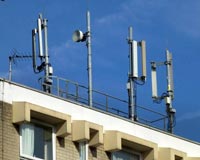In the early 1990s, many landowners thought (and perhaps rightly so) that they had struck lucky when they were approached by telecommunications operators who wanted to rent under-utilised spaces to create “cell sites” to host their apparatus. Landlords could make generous returns by hosting one or more telecommunications operators, and for seemingly little inconvenience. However, that income has generally gradually reduced in real terms. In order to get the best returns, landowners should keep abreast of changes in the market which affect cell site usage. The following article explains the matters to which landlords of telecommunications cell sites should be alive.
Making the network faster
It has been necessary to improve telecommunications infrastructure as the demands consumers have placed on the network have increased. As a result, the network standard has increased from “2G” to “4G”. The next stage will be the roll out of “5G”, which it is hoped will be live in 2020. The roll out of 3G and 4G necessitated the installation of improved apparatus and it is highly likely that the apparatus will need to be replaced again to accommodate 5G. Landowners should consider how the replacement apparatus fits with the lease terms, and whether an increase in rent follows.
Mergers in the market
Two major deals have recently been considered by the competition authorities. BT made an offer to take over EE, and Three (owned by Hutchinson) wants to merge with O2 (owned by Telefonica). The merger of EE and BT has been provisionally approved, while the European authorities will hopefully decide next year whether to approve the Three/O2 merger. Whether one or both of the deals go ahead, the changes in the market are likely to mean that demand for cell sites will alter.
BT has previously struck a deal with EE to use its signal, which enabled its recent re-entry into the market, even though it does not have its own mobile network infrastructure. If it completes its expected takeover of EE, then it will acquire network infrastructure, giving it a platform to further expand. Initially,
its share of the market would be the same as that which EE currently has (about 30%).
If the merger of Three and O2 proceeds, the combined new company is expected to have a market share of more than 40% . There would also be just three key players in the market which have their own infrastructure – Vodafone, Three/O2 and EE.
Joint ventures
While the prospect of these mergers completing is currently a hot topic, many people are unaware that operators have already been working together for several years. Those with their own infrastructure have done so by what they call the “sharing” of cell sites.
“Sharing” has helped operators to reduce their outgoings on rent, and to quickly expand their network coverage. It can take place either “passively” or “actively”. Passive sharing involves the physical sharing of a cell site by two operators, ie the original tenant operator allows another operator to install its equipment onto the radio base station site, in return for a fee, thereby reducing its rent expenditure. Active sharing describes the situation when an operator installs apparatus on a site which can transmit both its own signal and that of another operator.
Historically, operators involved in passive sharing arrangements kept their landlords happy by inserting a “payaway” clause into their leases. This obliges the original operator tenant to pay the landlord a share of the profit it receives from the additional occupants of the site – albeit generally a comparatively small slice of that profit.
Three and T-Mobile began working together to passively share sites in 2007 through MBNL, a joint venture company. MBNL increased the number of sites it manages when T-Mobile UK and Orange UK subsequently merged to form EE.
EE and Three later switched tactics, and in 2014 they began actively sharing their sites. In 2012, Vodafone and Telefonica also began working together through a joint venture company known as CTIL, and they too actively share their sites.
Impact on landlords
Since multiple operators can now occupy one single site, the effect of sharing has been to reduce the proliferation of telecoms equipment. While this is good for the environment, it reduces income for landlords.
Where a rooftop, for example, has been leased to two operators who now work together in a joint venture, then the operators have been looking to exit one of the leases – even if that is not strictly possible under the lease terms. That can halve the rent that the landowner receives. On renewal of a lease to an operator working within a joint venture, the operators will also try to insert provisions to allow them to “share” the site with their joint venture partner, for no extra rent if possible.
It is yet to be announced what will happen to these joint ventures if the planned deals go ahead. Will the joint ventures disband, and the operators start working on their own, increasing demand for sites? Or will further sites be shed as more active sharing arrangements are struck? What is apparent is that leases need to be drafted to cover future changes in the market, and landowners need to be savvy to protect their returns. It is for that reason that we recommend that landowners always instruct professionals with experience of working with the operators.
.
Leanne Meredith is an associate and Alison Hardy is a partner at Squire Patton Boggs








